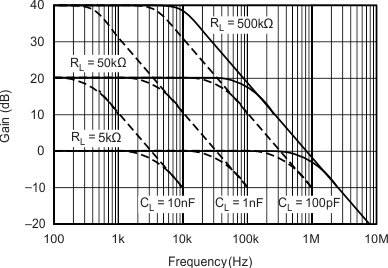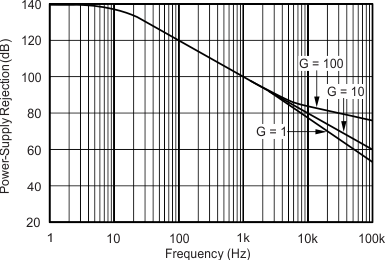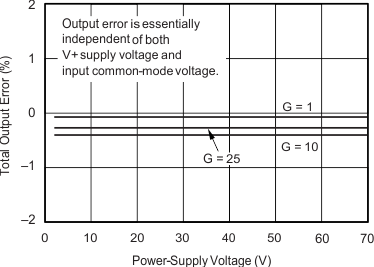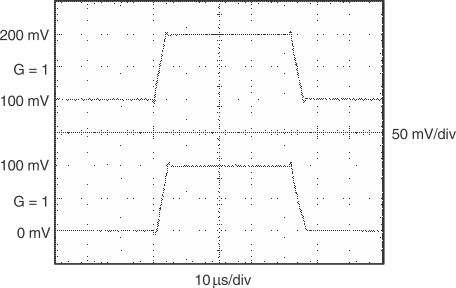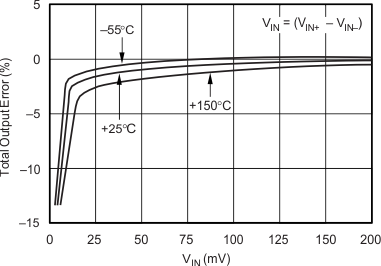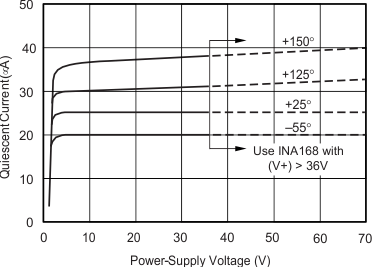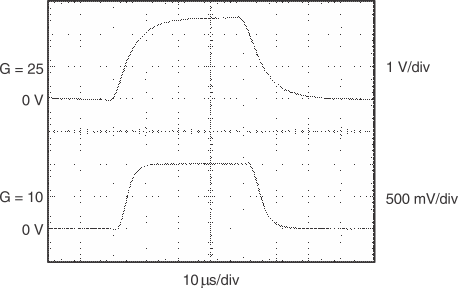SBOS122E December 1999 – December 2017 INA138 , INA168
PRODUCTION DATA.
- 1 Features
- 2 Applications
- 3 Description
- 4 Revision History
- 5 Pin Configuration and Functions
- 6 Specifications
- 7 Detailed Description
-
8 Application and Implementation
- 8.1 Application Information
- 8.2 Typical Applications
- 9 Power Supply Recommendations
- 10Layout
- 11Device and Documentation Support
- 12Mechanical, Packaging, and Orderable Information
Package Options
Mechanical Data (Package|Pins)
- DBV|5
Thermal pad, mechanical data (Package|Pins)
Orderable Information
6 Specifications
6.1 Absolute Maximum Ratings
over operating free-air temperature range (unless otherwise noted) (1)| MIN | MAX | UNIT | ||||
|---|---|---|---|---|---|---|
| Voltage | Supply, V+ | INA138 | –0.3 | 60 | V | |
| INA168 | –0.3 | 75 | ||||
| Analog input, VIN+, VIN– | INA138 | Common mode(2) | –0.3 | 60 | ||
| Sense voltage, VSENSE = (VIN+ – VIN–) | –40 | 2 | ||||
| INA168 | Common mode(2) | –0.3 | 75 | |||
| Sense voltage, VSENSE = (VIN+ – VIN–) | –40 | 2 | ||||
| Analog output, OUT pin(2) | –0.3 | 40 | ||||
| Current | Input current into any pin | 10 | mA | |||
| Temperature | Operating, TA | –55 | 150 | °C | ||
| Junction, TJ | 150 | |||||
| Storage, Tstg | –65 | 150 | ||||
(1) Stresses beyond those listed under Absolute Maximum Ratings may cause permanent damage to the device. These are stress ratings only, which do not imply functional operation of the device at these or any other conditions beyond those indicated under Recommended Operating Conditions. Exposure to absolute-maximum-rated conditions for extended periods may affect device reliability.
(2) The input voltage at any pin may exceed the voltage shown if the current at that pin is limited to 10 mA.
6.2 ESD Ratings
| VALUE | UNIT | |||
|---|---|---|---|---|
| V(ESD) | Electrostatic discharge | Human-body model (HBM), per ANSI/ESDA/JEDEC JS-001(1) | ±1000 | V |
| Charged-device model (CDM), per JEDEC specification JESD22-C101(2) | ±500 | |||
(1) JEDEC document JEP155 states that 500-V HBM allows safe manufacturing with a standard ESD control process.
(2) JEDEC document JEP157 states that 250-V CDM allows safe manufacturing with a standard ESD control process.
6.3 Recommended Operating Conditions
over operating free-air temperature range (unless otherwise noted)6.4 Thermal Information
| THERMAL METRIC(1) | INA1x8 | UNIT | |
|---|---|---|---|
| DBV | |||
| 5 PINS | |||
| RθJA | Junction-to-ambient thermal resistance | 168.3 | °C/W |
| RθJC(top) | Junction-to-case (top) thermal resistance | 73.8 | °C/W |
| RθJB | Junction-to-board thermal resistance | 28.1 | °C/W |
| ψJT | Junction-to-top characterization parameter | 2.5 | °C/W |
| ψJB | Junction-to-board characterization parameter | 27.6 | °C/W |
(1) For more information about traditional and new thermal metrics, see the Semiconductor and IC Package Thermal Metrics application report.
6.5 Electrical Characteristics
all other characteristics at TA = +25°C, VS = 5 V, VIN+ = 12 V, and ROUT = 125 kΩ (unless otherwise noted)| PARAMETER | TEST CONDITIONS | INA1x8 | UNIT | ||||
|---|---|---|---|---|---|---|---|
| MIN | TYP | MAX | |||||
| INPUT | |||||||
| Common-mode rejection | VSENSE = 50 mV | INA138, VIN+ = 2.7 V to 36 V | 100 | 120 | dB | ||
| INA168, VIN+ = 2.7 V to 60 V | 100 | 120 | |||||
| Offset voltage(1) | TA = 25°C | ±0.2 | ±1 | mV | |||
| TA = –40°C to +125°C | ±2 | ||||||
| Offset voltage drift(1) | TA = –40°C to +125°C | 1 | µV/°C | ||||
| Offset voltage vs power supply, V+ | VSENSE = 50 mV | INA138, V+ = 2.7 V to 36 V | 0.1 | 10 | µV/V | ||
| INA168, V+ = 2.7 V to 60 V | 0.1 | 10 | |||||
| Input bias current | TA = 25°C | 2 | µA | ||||
| TA = –40°C to +125°C, INA138 | 10 | ||||||
| OUTPUT | |||||||
| Transconductance | VSENSE = 10 mV to 150 mV, TA = 25°C | 198 | 200 | 202 | µA/V | ||
| VSENSE = 100 mV, TA = –40°C to +125°C | 196 | 204 | µA/V | ||||
| Transconductance drift | TA = –40°C to +125°C | 10 | nA/°C | ||||
| Nonlinearity error | VSENSE = 10 mV to 150 mV | ±0.01% | ±0.1% | ||||
| Total output error | VSENSE = 100 mV | TA = 25°C | ±0.5% | ±2% | |||
| TA = –40°C to +125°C | ±2.5% | ||||||
| Output impedance | 1 || 5 | GΩ || pF | |||||
| Voltage output swing | To power supply voltage, V+ | (V+) – 0.8 | (V+) – 1.0 | V | |||
| To common-mode voltage, VCM | VCM – 0.5 | VCM – 0.8 | V | ||||
| FREQUENCY RESPONSE | |||||||
| Bandwidth | ROUT = 5 kΩ | 800 | kHz | ||||
| ROUT = 125 kΩ | 32 | kHz | |||||
| Settling time | To 0.1% | 5-V step, ROUT = 5 kΩ | 1.8 | µs | |||
| 5-V step, ROUT = 125 kΩ | 30 | µs | |||||
| NOISE | |||||||
| Output-current noise density | 9 | pA/√Hz | |||||
| Total output-current noise | BW = 100 kHz | 3 | nA RMS | ||||
| POWER SUPPLY | |||||||
| Quiescent current | VSENSE = 0 V, IO = 0 mA |
TA = 25°C | 25 | 45 | µA | ||
| TA = –40°C to +125°C | 60 | µA | |||||
(1) Defined as the amount of input voltage, VSENSE, to drive the output to zero.
6.6 Typical Characteristics
At TA = +25°C, V+ = 5 V, VIN+ = 12 V, and RL = 125 kΩ, unless otherwise noted.